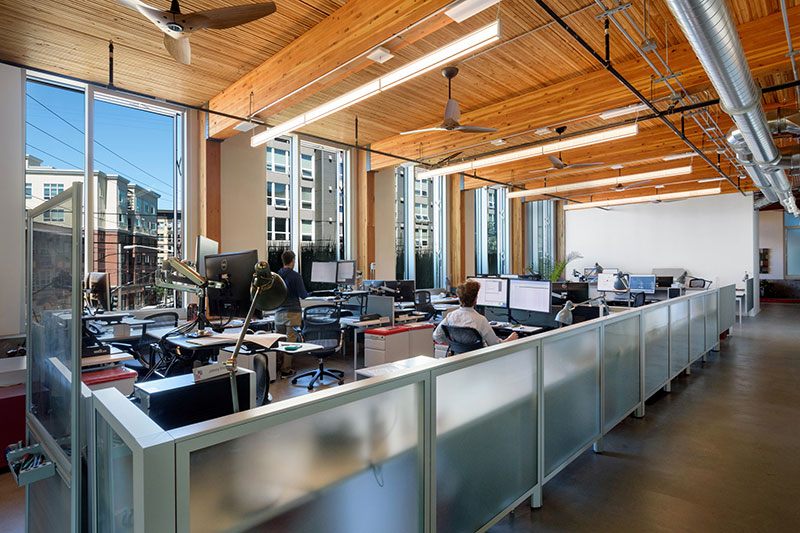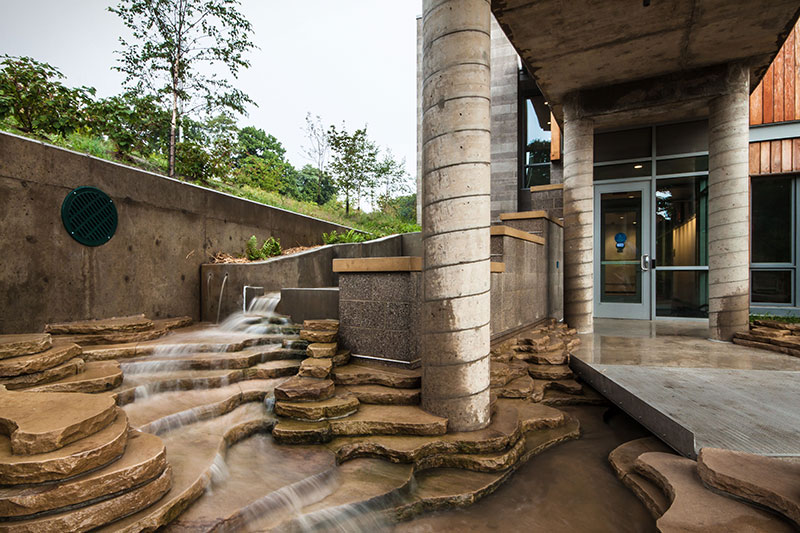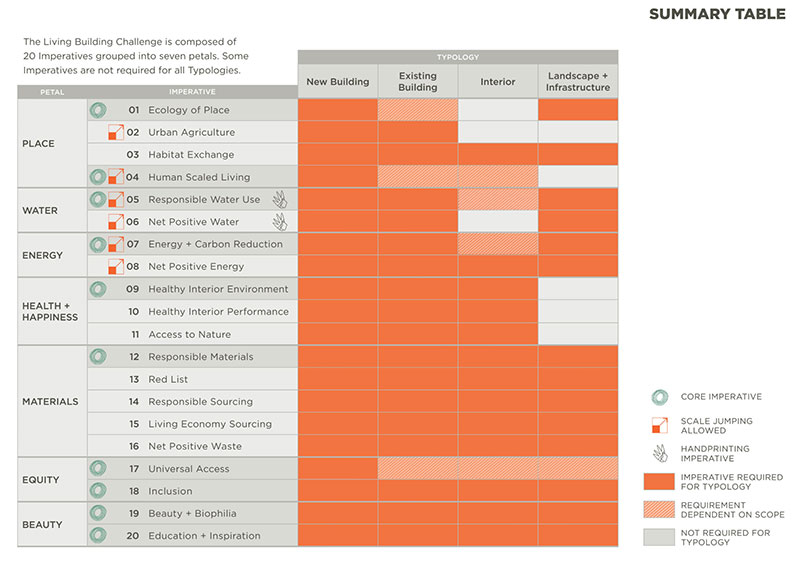The Living Building Challenge: An Overview
By Amy Nelson
The Living Building Challenge (LBC) is the built environment’s most rigorous performance standard. Fostering a symbiotic relationship between people, community, and nature, the LBC dramatically raises the green building bar from a mindset of “doing less harm” to one of actively stewarding and co-creating ecologically restorative, socially just, and culturally rich world communities. A truly Living Building is self-sufficient, connects its occupants to light, air, food, nature, and community; and creates a positive impact on the human and natural systems with which it interacts. While the International Living Future Institute openly admits that the LBC is “a philosophical worldview cloaked within the frame of a certification program,” it is a rigorous, well-structured, and clearly articulated framework for design and construction.

The LBC framework is formed around seven performance area “Petals”– Place, Water, Energy, Health & Happiness, Materials, Equity, and Beauty. Each Petal includes specific “Imperatives,” or requirements, that the building must achieve. Like nature itself, the LBC continuously evolves in response to feedback, and its latest version (4.0) contains 20 Imperatives. The LBC categorizes projects into four Typologies: New Building, Existing Building, Interior, and Landscape & Infrastructure. Some imperatives are not required for all typologies. (For example, the “Urban Agriculture” Imperative is not required for an Interior project.) Ten of the Imperatives are considered “Core” best practice achievements that a building must obtain to be considered a green or sustainable building. The LBC does not prescribe methodologies for achieving its Imperatives; rather it relies on leading edge technical knowledge and genius of integrated LBC design teams, owners and occupants. Each Petal has its own, detailed handbook, which includes Imperative clarifications and, in some cases, permissible exceptions. An overview of the LBC would not be complete without a brief description of the intent and function of each of its seven Petals.
PLACE
The Place Petal is intended to realign how people understand and relate to the natural environment that sustains us. This petal clearly articulates where it is acceptable to build, how to protect and restore a place once it has been developed, and how to encourage the creation of communities that are based on the pedestrian and not the automobile. The first Imperative within the Place Petal is one that may be of particular interest to Leaf Litter readers: Ecology of Place. This Core Imperative aims to protect wild and ecologically significant places. It forbids building within a floodplain, for example. It also requires project teams to document site ecology and reference habitats and to demonstrate that the project will restore or enhance the site’s ecological performance. The Site Petal also includes a Habitat Exchange Imperative, which requires that for each hectare of development, an equal amount of land away from the project site must be set aside in perpetuity.
WATER
The intent of the Water petal is to realign how people value water, address the energy and chemicals involved in bringing clean water to our taps, and redefine “wastewater” as a precious nutrient and resource. The first (and Core) Imperative within this Petal is Responsible Water Use, which prohibits potable water use for irrigation and requires projects to use less water (50% for New Buildings; 30% for Existing Buildings) than a baseline regional building. It also requires on site treatment of all stormwater without chemicals, as well as management of all stormwater based on pre-development hydrology and site ecology. The Imperative also states that projects Combined Sewer Overflow systems must incorporate stormwater detention and avoid sheet flow from the site. The Water Petal’s second and only other Imperative, Net Positive Water, requires that water used and released by a project work in harmony with the natural water flows of the site and its surroundings. This means the project must supply all of its water needs through captured precipitation, other natural closed-loop water systems, and/or water recycling. The Imperative calls for all grey and black water to be treated on site and for the project to incorporate a resilience strategy to provide drinking water for one week.

ENERGY
The Energy Petal aims to create new sources of renewable energy that allow projects to operate year-round in a resilient, carbon pollution-free manner. The Petal also optimizes energy efficiency as a means to reduce wasteful spending–not only of energy but of resources and capital. Through its two Imperatives, Energy & Carbon Reduction (Core) and Net Positive Carbon, the Energy Petal requires projects to supply 105% of their energy needs through on-site, renewable energy and to reduce (by 70% for New Buildings, 50% for Existing Buildings, and 35% for Interior projects) net annual energy consumption, compared to typical buildings with comparable climates, sizes, use, and occupancy.
HEALTH
The intent of the Health Petal is to create healthy spaces that allow all species to thrive by connecting people to nature and ensuring that indoor spaces have healthy air and natural daylight. The Petal’s three Imperatives, Healthy Interior Environment (Core), Healthy Interior Performance, and Access to Nature, require buildings to have and promote good indoor air quality, provide operable windows for all occupants, and provide 95% of occupants with access to views and daylight (as well as opportunities for the remaining five percent to move to compliant spaces for a portion of their day). The Petal also requires that the project provide opportunities, both inside and outside of the building, for occupants to connect with nature.

MATERIALS
Regarded by many LBC owners and design teams as one of the most challenging components of the program, the Materials Petal strives to create a successful materials economy that is non-toxic, transparent, and equitable. It calls for the use of Responsible (Core Imperative) and Responsibly Sourced Materials (a Core Imperative), which requires project teams know not only what their building products are made of, but how they are made, where their materials come from, and how those materials are extracted and transported, etc. LBC projects must also abide by the Petal’s Red List Imperative. The Red List is a list of chemical classes, such as PCBs, PFCs, and VOCs, that LBC projects must avoid in 90% of their new materials cost. ILFI’s Declare® label, which lists a product’s ingredients and provides information about its manufacturing and life expectancy, is a helpful tool–and one that must be used in the selection of at least one product per 200 sq m of project area–in achieving compliance with the challenging Materials Petal.
EQUITY
The intent of the Equity Petal is to elevate equity to a project goal and transform developments to foster just and inclusive communities that enable all people to participate, prosper, and reach full potential. The Equity Petal is comprised of two Imperatives, both of which are Core: Universal Access and Inclusion. Together, they ensure that Living Buildings are not only accessible and welcoming to all people; but also designed, built, and operated through processes that include and create jobs and opportunities for people who have typically been excluded, disadvantaged, or discriminated against. The Universal Access Imperative prevents projects from blocking access to or diminishing the quality of fresh air, sunlight, and natural waterways to anyone or any adjacent development. It also requires projects to make all primary transportation, roads, and externally focused, non-building infrastructure accessible to all members of the public, including the homeless.
BEAUTY
The Beauty Petal recognizes the need for beauty and connection to nature as a precursor to caring enough to preserve, conserve, and serve the greater good. While the LBC does not define “beauty,” this Petal requires teams to embrace biophilia, the notion that humans have an urge, an innate need, to connect with nature. The Petal’s Beauty & Biophilia Imperative (Core) requires teams to engage in a minimum one-day exploration of the project’s biophilic design potential, which must result in a framework and plan to incorporate nature and its patterns, as well as public art that celebrates the culture and spirit of place, into the project. The Education and Inspiration Imperative (Core) requires that project teams include one Living Future Accredited Professional and create public education opportunities and materials that can catalyze broader change.

LBC certification is based on actual–not modeled; not anticipated–performance. Once projects have completed construction and a 12-month operational period, they can pursue certification under one of five paths:
Full Living Building Certification: Project must achieve Imperatives required for its Typology.
Petal Certification: Project must achieve all Core Imperatives in addition to all Imperatives in either the Water, Energy, or Materials Petal.
CORE Green Building: Project must achieve all 10 Core Imperatives and verify performance for water and energy through a 12-month performance period.
Zero Energy: Project must achieve net zero energy through on site production of renewable energy, with no combustion.
Zero Carbon: 100% of project’s operational energy use must be offset by new on- or off-site renewable energy. Project must have a targeted energy efficiency level and a reduction in the embodied carbon if its primary materials. 100% of carbon emissions impacts associated with construction and materials must be also disclosed and offset.
For more about the Living Building Challenge visit ILFI website, where you will find detailed guides and handbooks, abundant case studies, and loads of inspiration to take on this paradigm shifting challenge.
